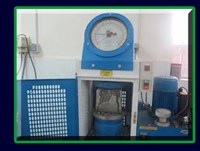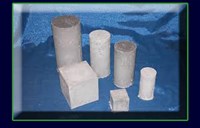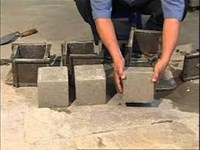مقاومت بتن سپتیک



تست مقاومت بتن :
ASTM C 109-92 prescribes aCement-Sand mix with following specifications:
Cement /Sand - 1:2.75
Water / Cement - 0.485
Type ofSand - Ottawa(Illinois)
CubeSize - 51mm (2 inches)
Loading conditions while carried out compression test ofabove prepared cubes should not be less than 20 secs. and no more than 80 secs.
Since cement gains strength over time, the time at whichstrength test is to be conducted must be specified. Typically times are 1 day(for high early strength cement), 3 days, 7 days, 28 days and 90 days (for lowheat of hydration cement).
Also, it should be noted that cement-mortar strength is notdirectly related to concrete strength. Strength of concrete is dictated by manyother factors. Cement-mortar strength is generally used as a quality controlmeasure of cement itself..
Following presents the strengthrequirements for the OPC cement as per the ASTM & NS standard at variousdays;
ASTM C 150 Portland Cement MortarCompressive Strength Specifications in MPa
As per NS Standard Cement Mortar Compressive StrengthSpecifications in MPa
Classification ofFine Aggregate
Natural sand, finely crushed stone and crushed gravel aretreated as “Fine Aggregates”. Aggregates used for making concrete normally liesbetween the range - with a maximum size of 80mm and a minimum of 150 micron.The maximum sizes of 80mm, 40mm, 20mm, 10mm, 4.75mm, 2.36mm, 600 micron, 300micron and 150 micron are more common.
The aggregate fractions from 4.75mm to 150 micron are termedas “Sand” or “Fine Aggregate”. Also, those from 4.75mm to 80 mm are termed as“Gravel” or “Coarse Aggregate”. The Size 4.75mm is a common fraction appearingboth in coarse & fine aggregate. These various sizes are usually divided bymeans of “Sieve Analysis”. Sieve Analysis is the operation of dividing a sampleof aggregate into various fractions each consisting of particles of the samesize. The Sieve Analysis is conducted to determine the particle sizedistribution in a sample of aggregate, which is also called “Gradation”.
Grading pattern of a sample of aggregates is assessed bysieving a sample successively through all the sieves mounted one over the otherin the other of size, with larger sieve on the top. The material retained oneach sieve after shaking represents the fraction of aggregate coarser than thecorresponding sieve and finer than the sieve above.
A single factor computed from the sieve analysis is used;known as “Fineness Modulus”. Fineness Modulus is defined as the sum of thecumulative percentages retained on the sieves of the standard series, dividedby 100. The standard series consists of sieves, each twice the size of thepreceding one (ASTM No. 100, 50, 30, 16, 8, 4) and up to the largest sieve sizepresent. Typical values of fineness modulus range from 2.2 to 3.2 withfollowing classifications:
Fine Sand : 2.2 – 2.6Medium Sand : 2.6 – 2.9
CoarseSand : 2.9 – 3.2
The usefulness of the fineness modulus lies in detecting slight variations inthe fine aggregates from the same source, which would affect the workability offresh concrete.


Iran Septic